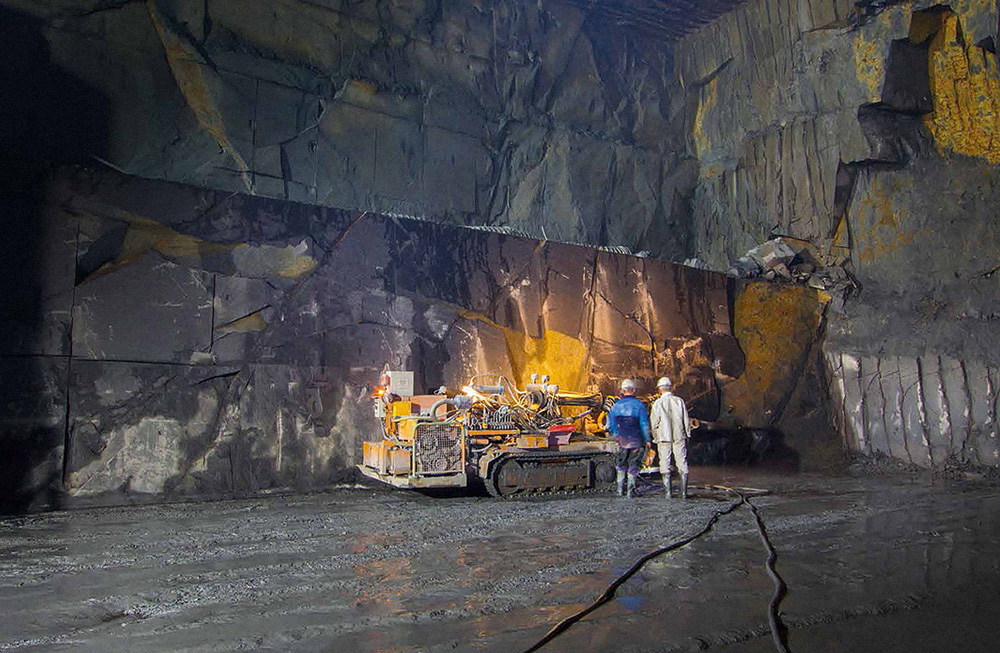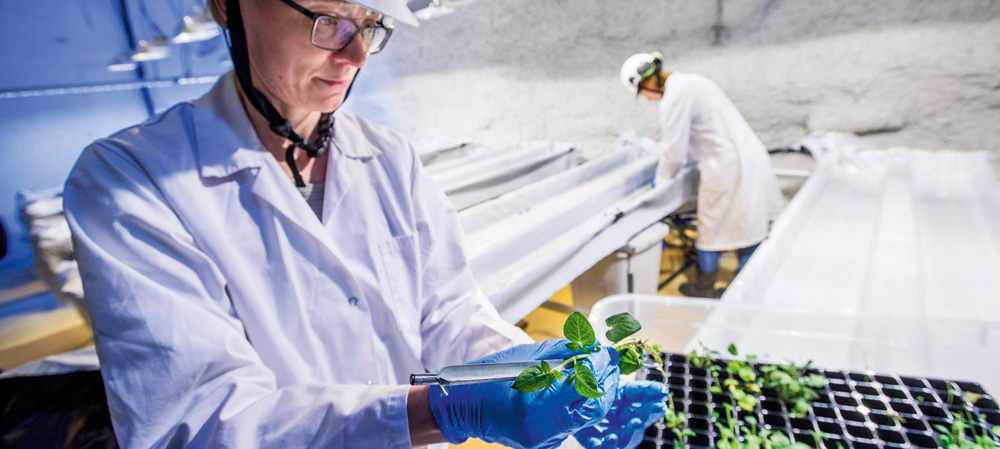Mine closure is a topic that is being discussed frequently as illustrated by the closure ceremonies of the last two German deep coal mines in December 2018. Besides the commemoration of the miners, the main question is what is to be done with the underground infrastructure of the abandoned mines? The closure of a mine can be cost-intensive; backfilling of cavities and shafts, and the necessary operation and maintenance of pumping systems, are only a few examples of this expense. Therefore, experts all over the world are researching possible subsequent uses of closed mines. Some interesting ideas for a subsequent use of underground cavities can be found under the keyword “Underground Farming”.
Introduction
Mine closure is a topic that is being discussed frequently as illustrated by the closure ceremonies of the last two German deep coal mines in December 2018. Besides the commemoration of the miners, the main question is what is to be done with the underground infrastructure of the abandoned mines? The closure of a mine can be cost-intensive; backfilling of cavities and shafts, and the necessary operation and maintenance of pumping systems, are only a few examples of this expense. Therefore, experts all over the world are researching possible subsequent uses of closed mines.
Many ideas and implementations are available. Langefeld and Binder describe in (1) and (2) how underground mines can provide additional uses to the actual mining process during operation, keywords “Blue Mining”, “Responsible Mining”. It is important here to include the planning of supplementary usages within the initial planning process of the mine to minimize expenses. Possible supplementary usages include electrical energy production, e. g., with geothermal heat, energy conversion, e. g., with pump storage plants, and the usage of underground cavities. Big cavities are accessible for many years after production, especially with mining methods such as room and pillar mining. An example is shown in Figure 1 (3) from a slate mine operated by the company MAGOG in Schmallenberg, Germany.

Fig. 1. Cavity at slate mine, MAGOG (3). // Bild 1. Hohlraum im Schieferbergwerk der Firma MAGOG (3).
Underground Farming as a new use of underground infrastructure
Mines can be used for storage or the depositing of residues, which are brought into the cavities and which also increase the stability of the cavity. Documents can be stored safely underground whereby the whole mine can be turned into a storage unit. Further usages include the transformation of the mine into a museum to preserve the history of the region for future generations. These usages are not restricted to closed mines but can be applied in operating mines as well. In such a case, a supplementary usage provides an additional source of income for the mine, which can be essential in times of volatile raw material prices. Some interesting ideas for a subsequent use of underground cavities can be found under the keyword “Underground Farming”.
Growing plants underground is still regarded as a niche application which is appreciated by experts, but mostly unknown to the public as well as in most specialist circles. The most common technique is the cultivation of white mushrooms, however, with the legalisation of cannabis this niche application is also gaining in popularity.
To understand this development, it is necessary to consider the whole spectrum of the cultivation of (medical) plants, starting from the technological possibilities, including agricultural practice, and concluding with legislative framework (4). Modern industrial scale agriculture supplies crops for food production, e. g. barley, wheat, sugar beets, as well as crops for industrial production of consumer goods, chemical products, paints, and coatings, e. g. oilseeds. The agricultural sector has achieved economy-of-scale through the combined use of large surface areas and efficient production technologies.
Whereas considerable amounts of food/plant equivalents are needed in daily nutrition – measured in grams – only few humans require daily medication based on medical plants. The active ingredient quantity of these medications is mostly in the range of milligrams, e. g., cardiac glycosides which have foxglove as their plant origin. Therefore, the share of the required annual medical plant production is small compared to the overall annual plant production for food.
Subsequently the cultivation of medical plants can be produced using smaller surface areas, smaller machinery and even semi-manual operations. Cultivation begins with direct sowing or planting of seedlings, which are supplied by a seed method, propagation by cuttings, or an in-vitro culture.
The regulatory requirements prohibit the application of sprays for the growing of crops, therefore herbicides are replaced by mechanical weed prevention and weed pulling. The process commonly referred to as weed killing can be achieved with special cultivation techniques such as growing crops under foil, however, manually weed killing may also be required. In general, the cultivation of plants must comply with the common pharmaceutical standards of the country of cultivation. In the case of differences between the legal regulations of the country of cultivation and the country of sale, both regulations and their proceeding requirements must be considered. Within the last two decades a comprehensive level of agreement has been reached with the legal guidelines of the European Union accepted worldwide (5). The cultivation on small areas with its associated frameworks is recommended for an adaption in underground cavities.
In general, underground farming describes the cultivation of plants or fungi underground in natural cave or anthropogenic cavities such as underground car parks, tunnels or mines. This concept allows for an alternative use of mines which also minimises the negative impacts of surface-based agriculture as underground farming does not require large surface areas. In case of using urban underground infrastructure the route of transport to the consumer can also be significantly reduced (6).
The plants are cultivated underground using hydroponic systems which means the plants are grown in an aqueous solution which provides them with all the required nutrients (7). The latest LED technology ensures that the plants receive sufficient light. In accordance with the specific needs of each crop the lightning and the nutrient solution can be adapted to ensure optimal growing conditions. In such a controlled environment negative impacts caused by parasites or extreme weather conditions do not o

Fig. 2. Underground Farming at the mine Pyhäjärvi; Pyhäjärven Kehitys Oy, Natural Resources Institute Finland (9). // Bild 2. Underground Farming im Bergwerk Pyhäjärvi; Pyhäjärven Kehitys Oy, Natural Resources Institute Finland (9).
ccur (8, 9).
The idea of growing crops underground is not a new one. An example for growing medicinal crops underground can be found at the copper mine Trout Lake, operated by Hudbay Minerals Inc., at Flin Flon/Canada. From 2001 to 2009 medical marijuana has been grown at this mine in underground growing chambers with the controlled access to the mine proving to be a major advantage. The pharmaceutical company in charge, Prairie Plant Systems (PPS), had been working with Hudbay Minerals for some time and has experience in growing a variety of plants underground including roses, tomatoes, and pharmaceutical crops. The contract between the mining operator and the pharmaceutical company expired in 2009. The Trout Lake mine has been closed in 2012 (10, 11).
A more recent example is presented by the ongoing research of underground farming at the Finnish mine Pyhäsalmi in Pyhäjärvi (Figure 2). The company First Quantum Minerals Ltd. plans to mine here copper, zinc, and pyrite in a depth of 1,450 m until 2019, however at the same time, different options for subsequent uses of the underground infrastructure post production are being explored under the project “Callio – Mine for Business”. A pilot project for growing potatoes and fibre nettles underground, e. g., was conducted from January 2017 until December 2018 (9, 12).
The perception of cannabis has changed significantly over the last few years. It used to be considered a dangerous narcotic because it was believed to be both addictive and a gateway drug. The one exception is hemp grown for fibre because hemp has a substantially lower THC content which is a relevant active narcotic ingredient in cannabis.
Recent scientific research provides a new evaluation of cannabis as a controllable legal stimulant. Furthermore, a medical interest is arising in marijuana as a promising treatment for severe illnesses and the alleviation of pain. For this reason, the legal requirements in Germany have been revised to provide the implementation of therapeutic usage of medical cannabis. A government agency assigns growing licenses via a tendering process to ensure the supply of cannabis for medical therapy.
However, cannabis is still subject to the Federal Law on Narcotics in Germany and therefore, its cultivation can only be conducted in closed and secured premises where there is a reliance on the use of LED lights and the use of classic substrates rather than in hydroponic systems.
The cultivation of cannabis is subject to the Good Agricultural and Collection Practice (GACP) (13, 14) as well as to the Good Manufacturing Practice (GMP) (15), if parts of the plant are used without further processing directly for therapeutic applications. Over the last years, the established cultivation of medical crops led to the publication of recognised implementation rules for the crop producers and the responsible persons regarding pharmaceutical drugs. These recommendations, including details on the qualification of suppliers (16) regarding the Federal Law on Narcotics, can be easily transferred to the cultivation of cannabis in underground cavities.
Outlook
Underground Farming in mines and in urban underground cavities is a current research topic which is investigating the potential subsequent use of existing underground infrastructure. Optimal growing conditions for different crops can be provided due to controlled environmental conditions resulting in high crop yields. Until now the number of research projects is small but there is potential for more future research, especially in Germany where there are several closed mines with partially accessible cavities as well as mines still in operation with a high potential for subsequent use. Further research is required regarding the adaption of environmental conditions in accordance with the needs of different crops.
References
References
(1) Langefeld, O.; Binder, A.: Blue Mining – Planning future mines today. In: World of Mining – Surface & Underground, pp. 109 – 112, 2017.
(2) Langefeld, O.; Binder, A.: Responsible Mining. In: Mining Report Glückauf (154) Heft 1/2018, pp. 26 – 33.
(3) Homepage der Firma MAGOG, Schmallenberg. Online available: www.magog.de.
(4) Hagels, H.; Strube, J.; Tegtmeier, M.: Pflanzen als Rohstoffbasis. In: CITplus 17 (12), pp. 6 – 8, 2014.
(5) European Medicines Agency: Guideline on Good Agricultural and Collection Practice (GACP) for Starting Materials of Herbal Origin. 2006. Online available: www.ema.europa.eu/documents/scientific-guideline/guideline-good-agricultural-collection-practice-gacp-starting-materials-herbal-origin_en.pdf.
(6) Growing Underground: Growing Underground. 2018. Online available: www.growing-underground.com. Accessed 25 November 2018.
(7) Hydroponik. 2018. Online available: www.erdelos.de. Accessed 28 November 2018.
(8) Rodionova, Z.: Inside London’s first underground farm. 3 Februar 2017. Online available: www.independent.co.uk/Business/indyventure/growing-underground-london-farm-food-waste-first-food-miles-a7562151.html. Accessed 25 November 2018.
(9) Pyhäjärven Callio: Plant Production. 2018. Online available: www.callio.info/natural-resources-business/kasvintuotanto. Accessed 25 November 2018.
(10) Kornelsen, K.: Hudbay Minerals continues to make history in Manitoba. 2012. Online available: www.miningandenergy.ca/manitoba/article/hudbay_minerals_continues_to_make_history_in_manitoba/. Accessed 28 November 2018.
(11) Naylor, J.: Reflections: Flin Flon’s “Marijuana Capital” era. 12 November 2016. Online available: www.thereminder.ca/news/local-news/reflections-flin-flon-s-marijuana-capital-era-1.2622063. Accessed 25 November 2018.
(12) First Quantum Minerals Ltd.: Pyhäsalmi. 2017. Online available: www.first-quantum.com/Our-Business/operating-mines/Pyhasalmi/default.aspx. Accessed 28 November 2018.
(13) Hagels, H.; Tegtmeier, M.; Strube, J.; Both, S.: GACP Regulation for Herbal Raw Materials. In: Plant Medica 79 (13), pp. 1105 – 1106, 2013.
(14) Graf vom Hagen-Plettenberg, M.; Klier, B.; Tegtmeier, M.; Waimer, F.; Steinhoff, B.: Good Agricultural and Collection Practice (GACP) – A Pragmatic and Efficient State-of-the-art Standard. In: Pharmazeutische Industrie 74 (7), pp. 1078 – 1084, 2012.
(15) Wagner, B.; Waimer, F.; Klier, B.; Tegtmeier, M.; Steinhoff,B.: Implementation of GMP for the Manufacture of Herbal Perparations: An Efficient and Successful Approach for Initial Steps. In: Pharmazeutische Industrie 76 (2), pp. 222 – 230, 2014.
(16) Raiser, M.; Hofmann, W.; Steckly, G.; Tegtmeier, M.; Torres Londono, P.; Steinhoff, B.: Qualification of Suppliers of Cultivated and Wild Collected Medicinal Plants. Pharmazeutische Industrie 79 (1), pp. 66 – 70, 2017.